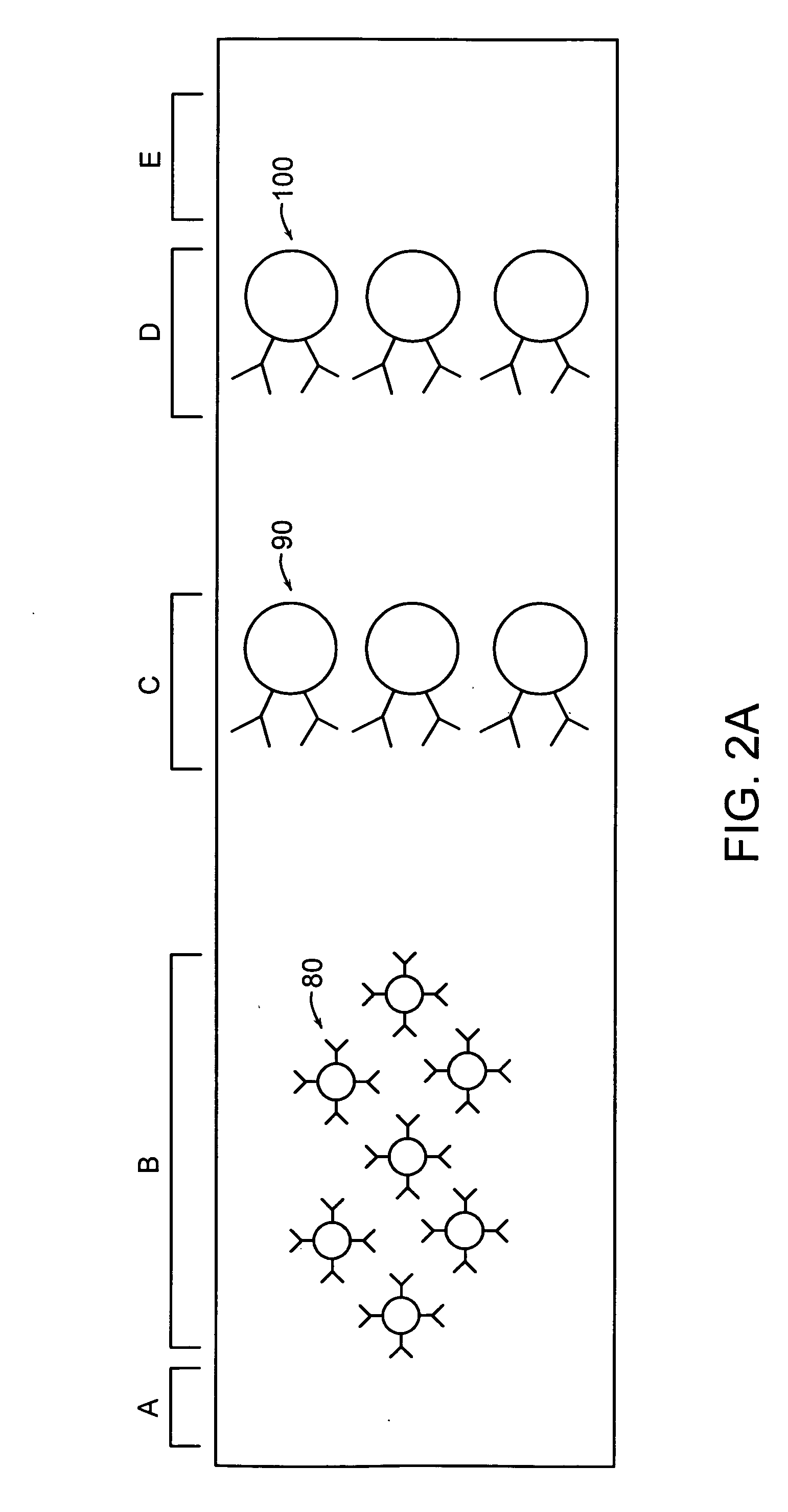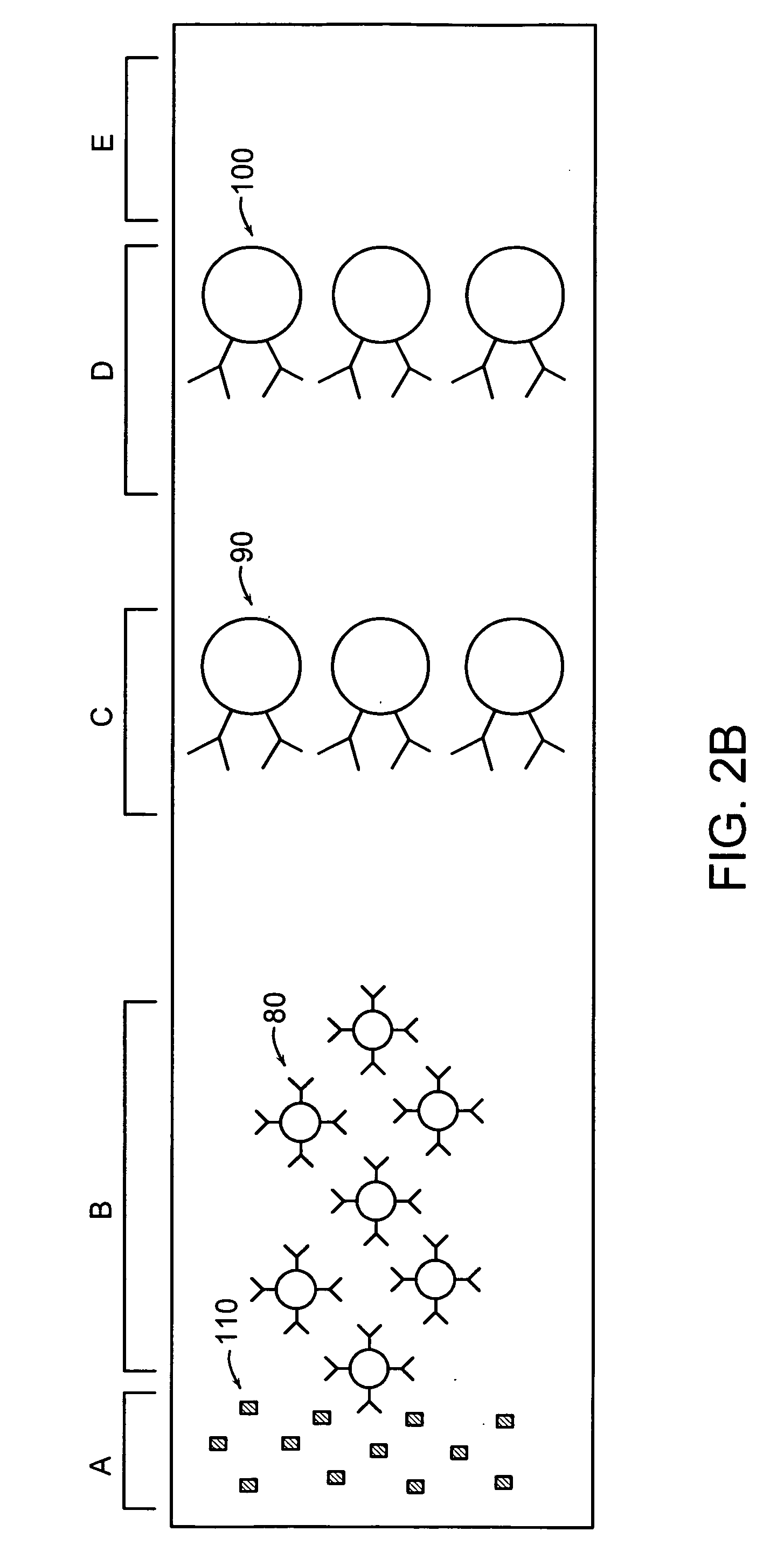Lateral flow format, materials and methods
a technology of lateral flow and material, applied in the field of lateral flow format and materials and methods, can solve the problems of complex tests, complicated manufacturing, and frequent flow problems of lateral flow tests
- Summary
- Abstract
- Description
- Claims
- Application Information
AI Technical Summary
Benefits of technology
Problems solved by technology
Method used
Image
Examples
example 1
Comparison of FUSION 5™ Absorbency with Other Materials
[0712] The absorbency of FUSION 5™ (Whatman plc), which can be used as the hydrophilic matrix in a preferred embodiment of the present invention, was compared with those of three other materials (CF3, CF4, and CF5), which are commonly used as industry standards. CF3, CF4, and CF5 are cellulose absorbents typically used in industry for lateral flow assays and are well-known in the art.
Protocol:
[0713] 10 ml of deioinzed water was placed into a Petri dish. A 5 cm2 piece of the absorbent was weighed before being placed into the water and left for 10 seconds. The absorbent was removed and the reweighed. Subtracting the dry weight from the wet weight gives the water absorbency for a 5 cm2 piece. This was performed 5 times for each absorbent.
Results:
[0714] The results of the experiment are shown in the bar graph of FIG. 3. The range of water absorbency per square centimeter for the three other materials was from approximately 30...
example 2
Comparison of FUSION 5™ Wicking Rate with Nitrocellulose Membranes
[0716] The wicking rate of FUSION 5™ (Whatman plc), which can be used as the hydrophilic matrix in a preferred embodiment of the present invention, was compared with the wicking rates of three nitrocellulose membranes (RP, FP, and SP). Among the nitrocellulose membrances, the RP membrane had the largest average pore size, while the SP membrane had the smallest average pore size.
Protocol:
[0717] 10 ml of deionized water was placed in a Petri dish. The wicking materials were cut to 5 cm lengths, with a make drawn using a soft pencil at 0.5 mm from the top and bottom edge. The wicking material was suspended from a clamp stand vertically, and lowered into the water until the water reached the 0.5 mm mark. The time for the water to wick to the top mark was recorded. This was repeated 3 times for each material.
Results:
[0718] The results of the experiment are shown in the bar graph of FIG. 4. The wicking rate for each ...
example 3
Conjugate Release of FUSION5™ Using Gold and Latex Carrier Beads
[0720] The conjugate release properties of FUSION 5™ were explored as a comparison between the release of gold carrier beads and latex carrier beads.
Protocol:
[0721] The conjugate (40 nm gold conjugate from Alchemy Labs, Dundee, UK; 288 nm dyed latex, Estapor, Paris, France) was diluted in either 18.2 MΩ water (MilliQ) or the appropriate buffer to a known optical density (OD10 at 520 nm). The conjugate (60 μl) was applied to a segment of FUSION 5™ conjugate pad from a pipette and the conjugate pad was dried to a consistent level of dryness (2 hours at 37° C. followed by storage for a minimum of 12 hours over dried silica gel). The amount of release was measured by placing the conjugate pad in 18.2 MΩ water (1 ml in a test tube), the amount of conjugate release was measured by reading the absorption in a spectrophotometer at 520 nm for gold and 280 nm for latex.
Results:
[0722] The results of the experiment are shown...
PUM
| Property | Measurement | Unit |
|---|---|---|
| pore size | aaaaa | aaaaa |
| pore size | aaaaa | aaaaa |
| pore size | aaaaa | aaaaa |
Abstract
Description
Claims
Application Information
 Login to View More
Login to View More - R&D
- Intellectual Property
- Life Sciences
- Materials
- Tech Scout
- Unparalleled Data Quality
- Higher Quality Content
- 60% Fewer Hallucinations
Browse by: Latest US Patents, China's latest patents, Technical Efficacy Thesaurus, Application Domain, Technology Topic, Popular Technical Reports.
© 2025 PatSnap. All rights reserved.Legal|Privacy policy|Modern Slavery Act Transparency Statement|Sitemap|About US| Contact US: help@patsnap.com



